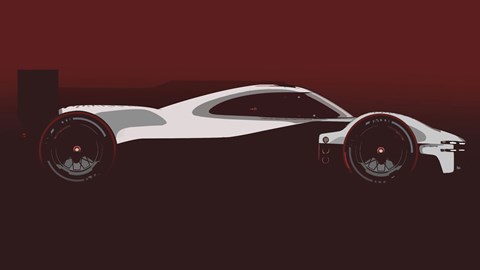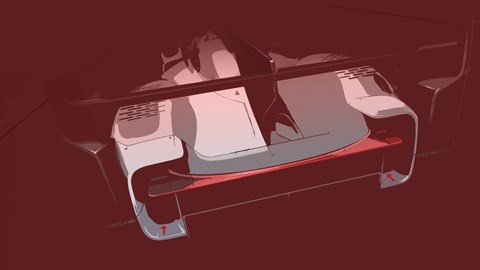► Porsche returns to top class at Le Mans
► Announces entry in new LMDh class from 2023
► It will face up against old nemesis Audi
Porsche’s new LMDh car has taken to the track for the first time in a shakedown session. Revealed on Porsche’s twitter account, it’s the first time we’ve been able to see the still camouflaged racer in motion,
Arriving in 2023, it’ll slot into the sport’s new LMDh rules – not Hypercar rules – and will be operated by the Penske team, but backed by Stuttgart.
As you’d expect, the new videos and images and don’t show much, but it’s possible to make out the same bulbous cabin and shrink-wrapped look we’ve come to expect from endurance racer. Like the 919 Hybrid before it, Porsche’s new challenger uses a huge rear wing, and efficient top exit exhausts sit just in front.

However, most interesting to aficionados of Porsche racers will be the horizontal rear LED light. Just like the legendary 911 GT1 of the 90s, it’s very possible that Porsche’s new racer will draw on elements of its current roadcars. If the new LMDh racer looks anything like the new 992, we’re in for a treat.
Teaming up with Penske
Porsche’s Le Mans programme will be a joint project with the Team Penske racing outfit, under an agreement that will see the Porsche hybrid race in both the IMSA and WEC classes, and is expected to run for several years.
‘We are delighted that we were able to get Team Penske to form this partnership,’ said Oliver Blume, Porsche boss. ‘For the first time in the history of Porsche Motorsport, our company will have a global team competing in the world’s two largest endurance series.’
Interestingly, Porsche is planning to have at least four factory LMDh cars on the grid but could supplement them with customer vehicles as early as 2023.
‘Our intention is to support and shape the new era with our LMDh prototypes,’ said Dr Michael Steiner, Porsche’s R&D chief. ‘Not only will we be keeping our fingers crossed for the four factory cars we have in total, but also for our customer teams.

‘The new LMDh vehicle will also be entered as a customer car in both series as early as the 2023 season. These partner teams will be given our full support. Whatever insights we gain from our factory effort will also be shared with them.’
It’s not the first time the two have worked together; Penske and Porsche teamed up from 2006 to 2008 in the ALMS series, and in the ’70s with the Porsche 917 in the Can-Am series.
It had been rumoured that Porsche would enter the hotly anticipated Hypercar class, but it will in fact compete in the new LMDh (Le Mans Daytona hybrid) class, which is being introduced in both the FIA World Endurance Championship (WEC) and IMSA series in North America.
That’s a class for prototype race cars with hybrid powertrains. The cars will weigh around 1000kg and turn out around 670bhp. Balance of Performance regulations will ensure they can fight for overall victory alongside the Hypercars. Both new classes come into effect next year.
The LMDh class has been created in collaboration between the WEC and IMSA to allow the same types of car to race for victory in major endurance race classics all over the world – handy for marketing the Porsche brand globally.
The sheer costs involved drove Porsche out of the LMP1 class last time, but it’s confident the new LMDh formula is more sustainable.
Why did Porsche choose LMDh instead of Hypercar?
‘It’s much more cost-efficient than Hypercar,’ Porsche’s director of factory motorsport Pascal Zurlinden told CAR. ‘IMSA and WEC are working for the closest possible racing.’
Porsche’s CEO Oliver Blume has said: ‘The new LMDh category allows us to fight for overall victories with a hybrid system at the Le Mans, Daytona and Sebring classics – without breaking the bank. The project is extremely attractive for Porsche.’
Why is LMDh cheaper to race in than LMP1?
Partly because it uses some ‘spec’ components, notably the control electronics for the hybrid powertrain. The chassis, too, won’t be made by Porsche: a choice of four racing car specialist manufacturers will supply chassis to companies entering the LMDh class. The chassis are based on upgraded LMP2 designs.
Porsche will supply its own combustion engine and design the body (said to take its design cues from some of the ‘unseen’ concepts recently revealed by Porsche’s design studio) but regulations tightly control the amount of engineering freedom they’ll have.
‘It’s really cost-effective; with BOP [Balance of Performance] you can’t buy performance,’ Zurlinden says. ‘[The use of] some spec parts is an important factor to reduce costs. Depending on how the class is received, we could go back to the ’80s and ’90s with lots of manufacturers [involved]. And with lots of customer cars in the mix too, this could become really big.’

Who will Porsche be racing against?
In the LMDh class, the big gun is Audi. Porsche and Audi (both part of the VW Group empire) last squared up against each other at Le Mans in 2016.
In the Hypercar class, Toyota will field its GR Super Sport and Glickenhaus its 007 model from 2021, and Peugeot will join in 2022.
While it hasn’t raced in the headline class at Le Mans since withdrawing from LMP1, Porsche has maintained a works presence in the closely fought GTE category with its 911 RSR.
Zurlinden says the Porsche works team will remain committed to that class for next season.